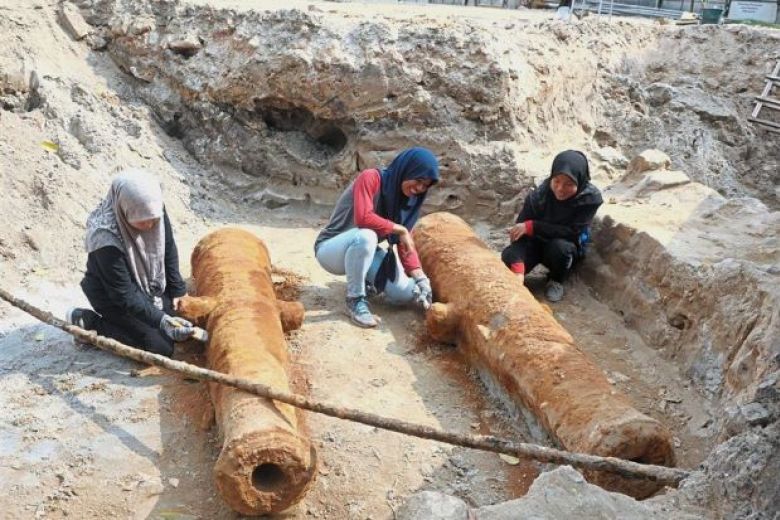Archaeologists discover 200-year-old cannons in Penang's Fort Cornwallis
Sign up now: Get insights on the biggest stories in Malaysia

The 2.2m and 2.35m-long cannons, which are believed to be at least 200 years old, were discovered during the excavation of the fort's moat and outer defensive structures on Feb 19, 2018.
PHOTO: THE STAR/ASIA NEWS NETWORK
Follow topic:
GEORGETOWN, Penang (THE STAR/ASIA NEWS NETWORK) - Archaeologists in Penang discovered twin cannons buried 1.2m below the ground beside the historic Fort Cornwallis at the Esplanade in Georgetown.
The 2.2m and 2.35m-long cannons, which are believed to be at least 200 years old, were discovered during the excavation of the fort's moat and outer defensive structures at around 2pm on Monday (Feb 19).
The findings came on the heels of an earlier discovery of cannonballs at the fort last year, reported local media.
Both bear the insignia "GR" - Georgius Rex which is Latin for King George - suggesting they were from the reign of King George III (1760 - 1820.
Penang chief archaeologist Datuk Dr Mokhtar Saidin said the discovery could change Fort Cornwallis' history as a "peaceful fort" .
"One of the interpretations was that the fort was not involved in any war.
"However, with the discovery of the cannons and cannonballs at the end of last year, we might have to take another look at the fort's history," he was quoted as saying by The Star newspaper.
"The diameter is about 10cm. It is quite big, and it must be for war," he said during a visit to the site on Tuesday.
yesterday.
Fort Cornwallis, named after the then Governor-General of Bengal Charles Cornwallis, was built by the East India Company (EIC) in the late 18th century.
The fort started as a stockade made of palm trunks after Captain Francis Light took possession of Penang Island from Kedah for the EIC in 1786.
It was then rebuilt by Indian convict labourers using bricks and stones during Colonel R.T. Farquhar's term as Governor of Penang, and was completed in 1810.
Though intended for military use, Fort Cornwallis never engaged combat during its operational history. Today, it remains to be the largest standing fort in Malaysia, reported Malaysian Insight.
Dr Mokhtar, who is also Global Archaeological Research Centre director at Universiti Sains Malaysia (USM), said the archaeological team was re-examining the 232-year-old fort based on a 1877 map as they were looking for the structure's main entrance.
"But we ended up with the two cannons at the 0.4ha site. We believe the top parts are made of copper and the inner parts could be iron," he said.
There were no markings of any cannons on the 1877 map.
"We will now conserve the artifacts and do a detailed study," he added.
Penang Chief Minister Lim Guan Eng, who granted permission for the excavation to be carried out, described the "double discovery" of cannons the festive Chinese New Year period as a "double ang pow" for the state government.
Georgetown is marking its 10th anniversary as a Unesco World Heritage site this year.
He said the area would be protected and security would be heightened at the archaeological site.
"The state government, in collaboration with George Town Conservation and Development Corporation, is working at rebuilding the moat that used to surround Fort Cornwallis.
"We want to bring the fort back to its original state, complete with a water-filled moat," he added.

